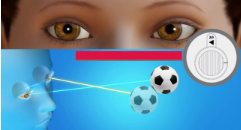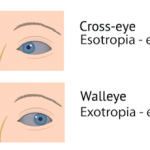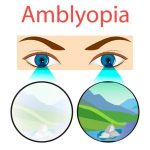Strabismus, commonly known as crossed crossed or misaligned eyes, is a visual condition that affects millions of people worldwide. This misalignment can lead to double vision (diplopia), reduced depth perception and even amblyopia (lazy eye).
It is either latent (phoria) or manifest(tropia) in appearance, usually proceeding from the former to the latter.
It occurs either as an inward (eso-) deviation, outward (exo-) deviation, upwards (hyper) deviations and downwards (hypo) deviation in either or both eyes.
It can be classified into two types, namely: comitant (concomitant) and in-comitant.
Comitant (Concomitant) strabismus: deviation does not vary in size with the direction of gaze.
In-comitant strabismus: deviation varies in size with the direction of gaze
It is also seen in two different forms namely; restrictive and paralytic
Restrictive strabismus: This is simply a reduced innervation of an extra-ocular muscle e.g. a reduced innervation of the lateral rectus causing outwards movement of the eye to become more difficult to perform.
Paralytic strabismus: This is simply a completely blocked innervation of an extra-ocular muscle, can be due to a palsy, trauma, injury or cut amongst others e.g. a paralysis of the lateral rectus will cause the outwards movement of the eye to become impossible.
It can occur due to muscle dysfunction, farsightedness, problems in the brain, trauma
or infections.
Risk factors includes; premature birth, cerebral palsy, family history, extra-ocular muscles palsy/injury.
Strabismus is usually treated with a combination of eye glasses (with/without prisms), vision therapy, medication (botulinum toxin therapy) and surgery, depending on the underlying cause and the clear goal and aim to prevent the occurrence of diplopia. However, use of prisms (non-invasive) is usually the most conventional, routine and frequent;y used plan for strabismic management with the others only being used in subtle, special or advanced cases.
A prism can simply be defined as a clear, wedge-shaped lens that bends light rays. There are several reasons for the use of prisms in strabismic management. These includes:
Correcting misalignment: This is one of the primary use of prisms in strabismus. Here, a prism is placed in front of the eye, to help re-direct the light entering the eye, this allows for the brain to perceive only a single and fused image, thereby allowing both eyes to work together easily and reducing eye strain.
Restoring binocular vision: Binocular vision is the ability to use both eyes together in harmony, it is crucial for depth perception and overall visual functions, however, it is usually reduced-to-eliminated in a strabismic eye, depending on the degree and cause of the strabismus. Here, prisms in addition to an intensive binocular vision therapy regime is essential, in order to try to restore and/or recover some amount of binocular vision
Managing diplopia: Diplopia is usually a common unpleasant symptom experienced by individuals with strabismus. In this case, the use of prisms will help to redirect light while allowing the image to remain one as a single object. This in turn, tends to greatly increase visual comfort and quality of life of all those affected.
Improving depth perception: Depth perception is the ability to perceive the relative distance of objects in three-dimensional space. It plays a crucial role in tasks such as judging distances, catching objects and navigating surroundings. Strabismus depending on its degree, usually causes depth perception to be reduced-to-impaired, therefore, prisms is the only way to improve and/or restore depth perception in a strabismic eye.
Enhancing visual comfort: Strabismus tends to cause eye strain, headaches and discomfort due to the constant effort required which in turn affects quality of life such reading, driving and social interactions.
Customized treatment: Some strabismus patients have a special order need, meaning that probably either the prism power and/or combo is rarely used or it usually not made in stock. In this case, the order for the prism is made with all necessary details so that it can be made for the special patient in need of it.
In as much as prisms are very effective, they are typical applied in a combo format (in addition to any other form of treatment. This is done in other to maximize result and reduce time lost.










